
There is a lot of emphasis on greener driving as we all push towards reducing our carbon emissions and a more sustainable. Transport emissions account for about 40% of Ireland’s energy related C02 emissions and the urge to reduce this figure has enticed a lot more motorists to opt for electric or hybrid cars. But it is not just about being ecologically responsible for the planet. Driving greener make sense financially too. There are almost 30,000 EVs under taxation in Ireland which includes almost 15,000 BEVs and almost 15,000 PHEVs as of the end of February 2021. There is a presumption that everyone fully understands the differences between the fully electric car, the Hybrid and the PHEV vehicle. Here is a quick and simple guide to the differences between these three options. As always, at Sandyford Motor Centre we have a wide range of cars in all fuel types and our friendly sales staff are here to assist you in finding the vehicle that best suits your needs.
With car manufacturers constantly improving technology on fully electric cars we can expect to see a wider range and a greater choice in EV vehicles in the future. Right now, there is already an increase in EV, Battery electric vehicle or fully electric cars on Irish roads. Electric cars are propelled by one or more electric motor, using energy that is stored in rechargeable batteries. In the past, only the most dedicated eco warrior drove fully electric as the thorny issues of range and lack of plug-in stations were off putting. However, these difficulties have faded fast, and more and more motorists are opting to drive BEV. Financially, it makes sense too as there are tax breaks and incentives to make the deal sweet. The obvious saving on fuel costs is the cherry on the EV cake and is sparking a surge in commercial fleets adopting EV cars.
Read more here about going electric for commercial vehicles.
As the name suggests, hybrid is a combination of fuel types. Hybrid cars have both a petrol or a diesel internal combustion engine and an electric motor. The electric motor in this case is not a plug-in recharge but is regenerated through the combustion engine. This means a better fuel economy than with petrol or diesel fuelled cars. The great advantage to Hybrid vehicles is the lack of worry about range on long journeys. Hybrids are very much seen as the easy way to ecological motoring without the concerns of finding recharging points. Hybrids are perfect cars for city living.
Plug-in hybrid electric vehicles use batteries to power an electric motor and use another fuel, petrol or diesel, to power an internal combustion engine. They vary from the Hybrid car as the electric generator battery can be recharged by plugging it into an outside power source as well as being charged by its on-board engine. The PHEV usually has a larger ‘self-charging’ battery so it can go a bit further on electric power alone before the engine kicks in. It is for many drivers, the best of both worlds although die-hard green drivers question their credentials as a truly green model. Most plug-in hybrids, however, reduce life cycle green-house gas emissions by 15%-30% as compared to an equivalent non-hybrid model. This is mainly due to the increase in fuel efficiency which results from hybridising the drivetrain.
For more information or if you want to discuss the options in more detail, you are always welcome to phone, call in or email us.